Black Aphids on Plants: Effective Ways to Kill Aphids on Indoor and Outdoor Plants
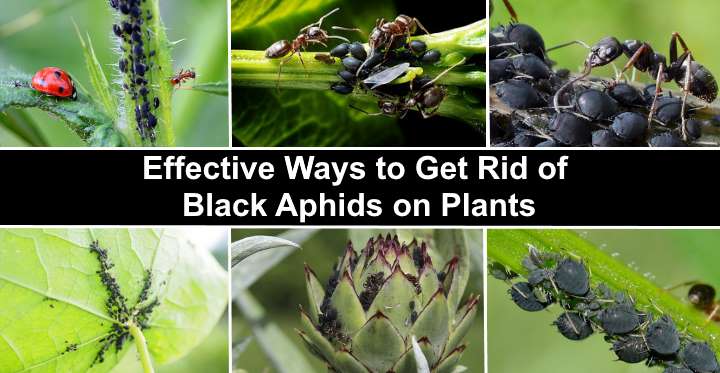
Black aphids are tiny black insects that suck juices from plant leaves and stems, leaving them distorted and damaged. Also called black bean aphids, the plant-destroying pests are typically found on the underside of leaves. You can spot the signs of black aphids by the sticky honeydew they secrete that causes sooty mold and attract hordes of ants. Thankfully, there are many ways to get rid of and control black aphids naturally.
The black aphid (Aphis fabae) is an insect species in the genus Aphis and the family Aphididae. The six-legged, soft-bodied insect is one of the more than 5,000 species of aphids. Like all aphids, the plant-feeding pests have mouthparts that pierce plant tissue and suck the sap. Black aphids may or may not be winged. But all types of aphids are significant pests on garden plants and crops.
Black aphids also have the common names black bean aphid, blackfly, and beet leaf aphid. These terms describe the type of plants that black aphids love to feed on. Crops such as beans, runner beans, and beet are top of the menu.
However, you will also find black aphids destroying viburnum plants, chamomile, poppies, and thistles. Unfortunately, there are very few plants in the garden immune from a black aphid infestation.
This article is a comprehensive guide to identifying and getting rid of black aphids. Eliminating black aphids from plants requires a multi-method pest control approach. Therefore, you will also learn about the black aphid life cycle and how to prevent aphids from damaging your garden landscape.
What Do Black Aphids (Aphis fabae) Look Like?

A close up picture of black aphids and tiny aphid nymphs
The black aphid has a rounded, pear-shaped, soft, dark-green to black body, bulbous abdomen, six pale yellow legs, and two antennae. Close-up pictures of black aphids reveal that their light-colored legs and antennae have black markings on them. There are also two tube-like black cornicles at their rear.
Black aphids are difficult to spot because they only measure 0.12” (3 mm) long. However, their dark-colored bodies and the fact they feed in large clusters make it easier to identify black aphids than other aphid species.
You may notice that some black aphids have wings, whereas other don’t. Typically, the flying winged black aphid has a slenderer body without the characteristic tear-shaped body of non-winged black aphids. Black aphids that fly—called blackflies—are a significant pest in gardens because they can easily infest nearby plants and crops.
Black aphid nymphs look like mature, adult aphids. However, because they measure less than 1 mm, it is almost impossible to see them without a microscope.
Related reading: How to identify woolly aphids.
Black Aphids Life Cycle
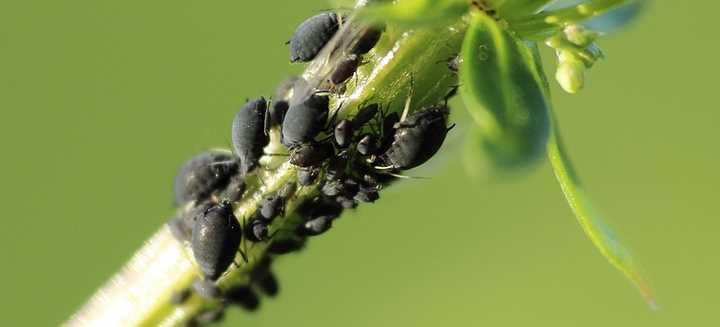
Black aphid life cycle starts as an egg or a live nymph, depending on the time of the year
The life cycle of a black aphid starts as an egg, then goes through several nymphal stages before reaching maturity. From hatching in spring, molting several times, and reaching adulthood, it takes the black aphid approximately 15 days. The first wave of hatched females, which emerge in late winter/early spring, give birth to live aphids without mating. During their lifespan, they can produce several generations of winged and wingless black aphids.
In the fall, the black female aphids mate with males, lay eggs, and then overwinter. The aphid lifecycle starts the following spring again. Researchers reckon that around 40 percent of black aphid eggs survive the winter.
Unless you take measures to control black aphids in winter, spring, and summer, there can be thousands of tiny soft-bodied insects on a single plant, sucking the juices from leaves and stems.
Knowing about the life cycle of black aphids is key to getting rid of them from your garden. First, it’s important to apply horticultural oils to plants during winter to kill off the eggs before they hatch. Then during spring and summer, it’s vital to use a combination of several pest control methods to stop the black bean aphids from destroying your plants.
Where Do Black Aphids Come From?
Black aphids come from the plants where they overwinter. There are around 300 species of plants that black bean aphids lay their eggs on. However, you will commonly find the eggs on spindle tree leaves and viburnum bushes during winter. In summer, the pesky pests can be found on beet leaves, legume plant foliage, and most types of crops.
Winged black aphids can also infest your plants by flying from nearby plants. In addition, the wind can carry them from nearby gardens to wreak havoc on your ornamental plants, vegetables, and flowering shrubs.
How to Identify Black Aphids on Plants
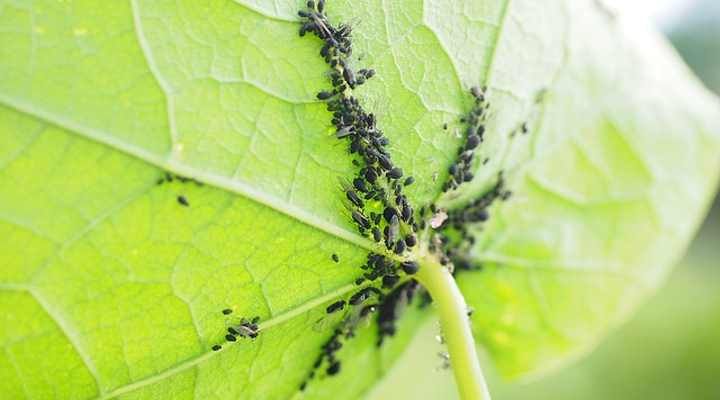
Black aphids on the underside of a leaf
The easiest way to identify black aphids on plants is to inspect the underside of leaves. If your plants have aphid problems, you’ll notice the tell-tale signs of clusters of hundreds of dark pear-shaped insects crawling around. The black, sap-sucking pests have identifiable light-colored legs with black feet, and pale yellow antennae.
Black aphid identification is also possible by inspecting plant damage. The distinctive injury to plants that aphids cause are misshapen or curled leaves, yellowing leaves, and poor plant growth. You may also notice an amber-colored sticky substance called honeydew on plant stems—a characteristic identifying sign of an aphid infestation.
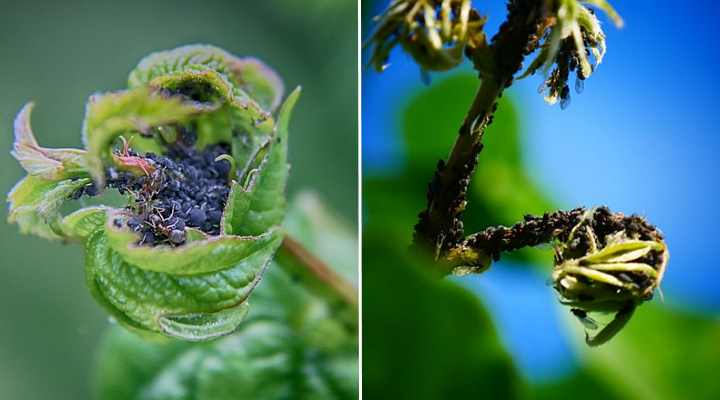
Black aphid infestation
The presence of honeydew—a sweet sticky residue—on plants helps identify black aphids in two ways. First, a black sooty mold develops on the foliage. Second, there are more ants around the aphid-infested plants.
One way of identifying black aphids—or any aphid species—is by looking for ants around the plant. Ants are attracted to honeydew. They will then protect aphids from attacks by beneficial insects like ladybugs that try to eat aphids.
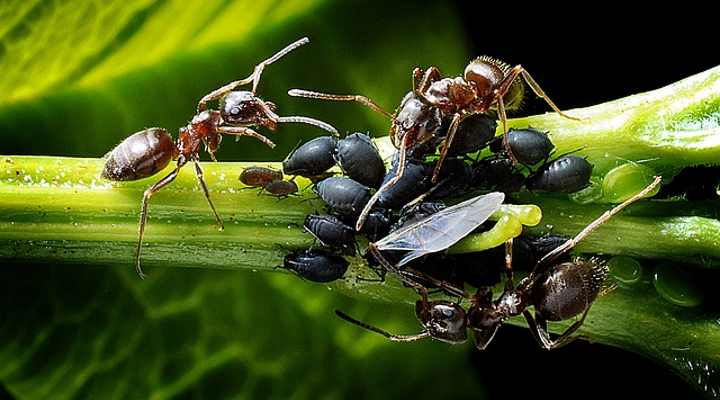
Ants feeding on the honeydew left behind by black aphids
Have you noticed small black bugs on hibiscus plants? The chances are that you have black aphids on your hibiscus, and the hundreds of minuscule insects feeding on hibiscus foliage could be damaging its growth. Often the best way of getting rid of black aphids on hibiscus plants is to blast them with a strong jet of water.
Signs of Black Aphid Plant Damage
Black aphid damage on plants is recognizable by yellowing leaves that appear crinkled or wilted, stunted growth, sticky substances, and a sooty mold. In some cases, thousands of black aphids on a plant can weaken it so much that it becomes susceptible to bacterial diseases that can eventually kill the host plant. So, a severe black aphid infestation can lead to plant death.
Here are the typical signs of plant damage caused by black aphids:
Yellowing leaves: When black aphids suck the juice from leaf tissue, the leaves turn yellow due to a nutrient deficiency. If you notice yellowing leaves on plants, check the undersides for blackfly, whitefly, or greenfly.
Foliage damage: Black aphids that attack plants cause the leaves to wither, curl, or become misshapen.
A sticky substance on stems or leaves: When black aphids suck sap, they leave behind honeydew. This sugary residue doesn’t directly damage plants. However, it can attract other pests that can cause more damage to your prized garden shrubs, flowers, and crops.
Black fungal growth: Sooty mold results from black aphids feeding on plants and leaving behind honeydew. The unsightly black substance harms the plant’s appearance.
Galls on plants: Bumpy growths on leaves, stems, branches, and roots are another type of damage that black aphids and other mites and bugs cause.
How to Get Rid of Black Aphids on Plants
Getting rid of black aphids can be a challenging task. The easiest way to kill aphids is to blast stems and leaves with water from a pressurized hose. Also, horticultural oils, insecticidal soaps, or neem oil help destroy aphids naturally. Finally, introducing predatory insects can help decimate black aphid populations.
Other effective ways for eliminating black aphids include avoiding planting trees or shrubs that attract them, keeping garden plants and crops healthy, and not using broad-spectrum pesticides.
Chemical insecticides may eradicate black aphids fast. However, you will also destroy beneficial insects that feed on aphids. By sticking to organic and eco-friendly pest control methods, you minimize the risk of contaminating the food chain if you grow vegetables or fruit.
Wash Infested Plants to Eliminate Black Aphids
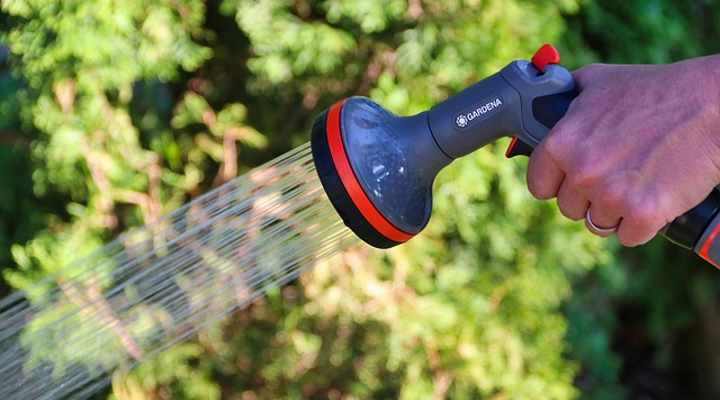
Get rid of black aphids by hosing them
The fastest method of eradicating blackflies from plants is to turn the garden hose on them. A super-strong jet of water is enough to remove soft-bodied black bean aphids and kill most of them in the process. The water method works well for getting rid of aphids from hibiscus, roses, bean plants, beet leaves, and other tender garden foliage.
Prune Infested Garden Plants for Black Aphid Control
A quick way to eradicate black aphids from plants is to remove infested stems and leaves. It’s a good idea to trim off badly damaged foliage. Pruning aphid-damage foliage and plant parts not only removes the annoying insects but allows the plant to concentrate energy on healthy parts of the plant.
Spray Plants with Neem Oil Spray to Kill Black Aphids
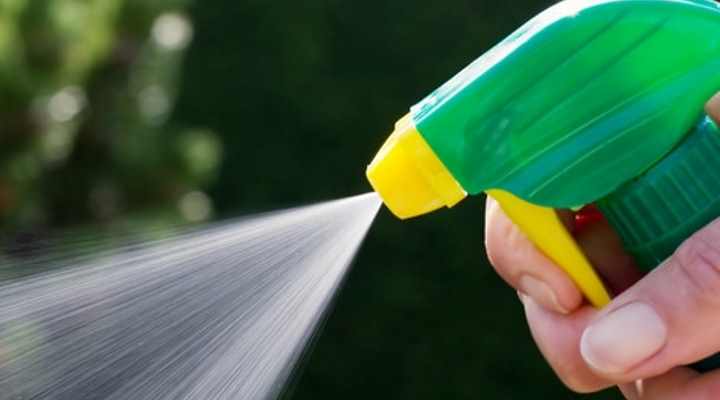
Spray neem oil to kill black aphids
Use an aphid spray with neem oil to get rid of the tiny black bugs on plants for good. To make the neem oil spray, combine 2 tsp. neem oil and 1 tsp. Castile soap with 1 quart (1 l) of water. Mix the ingredients thoroughly in a spray bottle. Then, liberally spray foliage weekly to kill black aphids.
Scientific studies have shown neem oil to be an effective natural pesticide for Aphis fabae (black bean aphid). One study found that neem oil solutions were just as effective as chemical insecticides for killing large populations of black aphids.
How to Use Insecticidal Soap to Get Rid of Black Aphids on Plants
A low-toxic method to eliminate black aphids from plants in your garden is to use insecticidal soap. Commercial insecticidal soap kills soft-bodied insects such as black aphids on contact without harming plants. The oils in the soap destroy the outer layer of aphids, causing them to die quickly.
To use insecticidal soap for black aphid control, follow the manufacturer’s instructions.
Apply Rubbing Alcohol to Kill Black Aphids
Rubbing alcohol (70%) is a fast way to kill black aphids on contact. You can use isopropyl alcohol by soaking a cloth with it and wiping down infested plant foliage. Or you can use an alcohol spray to treat aphid infestations on leaves.
To make a spray for black aphids, dilute 1 quart (1 l) of water with 1 cup of 70% rubbing alcohol. Pour the mixture into a spray bottle. Thoroughly douse all leaves, stems, and branches with the solution to destroy the tiny black pests. Use every seven days for best results.
Wiping down foliage and stems during winter is an excellent control method to prevent black aphids from hatching. In addition, the alcohol effectively destroys black aphid eggs.
Introduce Beneficial Insects for Black Aphid Control
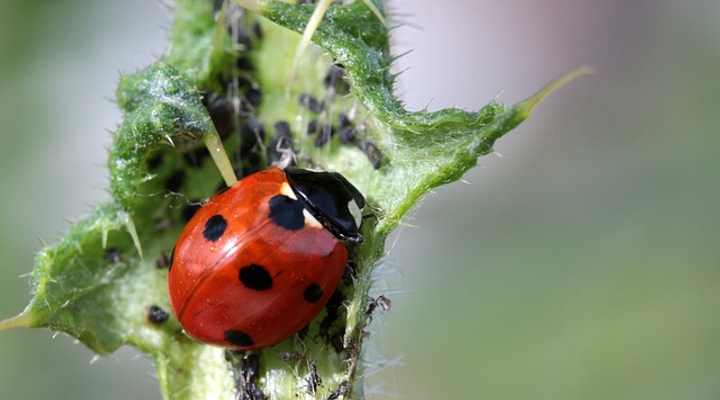
Ladybug feed on black aphids
Predatory insects such as lacewings, ladybugs, gall midges, and parasitic wasps are helpful in significantly reducing populations of black bean aphids. The beneficial insects feed on mites and sap-sucking insects. Therefore, you can use predatory insects to get rid of aphids naturally and to control them.
How to Use Epsom Salt to Eradicate Black Aphids Naturally
Using Epsom salt could help get rid of aphids by killing them on contact. Many gardeners believe spraying plant foliage with an Epsom salt spray acts as a natural aphid spray that doesn’t harm plants.
To try the Epsom salt method, dissolve 2 tbsp. Epsom salt in 1 gallon (3.8 l) water and add 2 tsp. Castile soap. Mix thoroughly to combine the ingredients. Spray foliage, flowers, branches, and stems that show signs of a black aphid infestation. Spray plants in the evening and wipe down foliage with a damp cloth the following morning.
Use Sticky Traps to Control Flying Black Aphids on Indoor Plants
Yellow sticky traps can help reduce the number of flying black aphids. The bright yellow color (some gardeners prefer blue sticky traps) attracts the flying black insects. They then stick to the traps and die. However, this aphid control method is only effective when used together with other treatments to eradicate black aphids.
How to Use Diatomaceous Earth for Black Aphid Control
Diatomaceous earth (DE) is a non-toxic pest control method that can help you win the battle against black aphids. DE kills off all kinds of harmful insects by destroying their soft bodies from the outside. After contact with the white powder, the tiny black pests quickly die.
To use diatomaceous earth to get rid of black aphids from plants, sprinkle dry foliage with the powder. Repeat the dusting once a week to help reduce the number of black aphids on garden bushes, fruit trees, vegetable leaves, and ornamental plants.
It’s good to remember that diatomaceous earth is only effective as a contact pesticide if it’s dry. So, after it rains or you water plants, you must wait until the plants are completely dry before reapplying.
How to Prevent Black Aphids
Get rid of ants to control black aphids. It’s vital to get rid of ants from aphid-infested plants. Ants will protect aphids and attack any predators. The presence of ants can make natural aphid control ineffective if you want to use beneficial insects to kill black aphids.
Inspect new houseplants. Black aphids typically don’t infest houseplants. However, common aphids can be a significant problem if you introduce them. In addition, the pesky “bugs” can quickly infest other plants. So as a general precaution, always inspect and isolate new houseplants to prevent any significant pest infestation on your houseplants.
Introduce beneficial insects. Environmental control with predatory insects like lacewings, parasitic wasps, and ladybugs can prevent black aphids from getting out of control.
Wipe plant foliage in winter. To prevent black aphids from hatching in spring, wipe down plants with a diluted alcohol solution. The plants commonly used by black aphids to lay eggs are viburnum shrubs and the common spindle (Euonymus europaeus).
Avoid over-fertilizing plants. Don’t over-fertilize plants to avoid attracting black aphids. Too much fertilization can stress and weaken plants, thus attracting aphids that weaken plants even more.
Use reflective mulch covers to prevent black aphids on garden plants. The University of California reports that reflective mulches such as silver polythene can reduce populations of aphids on plants. Putting down reflective mulch in early spring can help prevent and repel aphids from plants.
Avoid using broad-spectrum pesticides. It’s best to avoid chemical pesticides to rid your garden of black aphids because you will kill beneficial predatory insects at the same time.
Related articles:
